reflecting on the big events and the new developments
- Written by Bronwyn Hinz, Director of Research and Development, Pivot Professional Learning; and Honorary Fellow, University of Melbourne
This is a longer read at just over 1,500 words. Enjoy!
The year 2018 was a mixed bag for schooling policy in Australia.
We had new ministers, a new organisation and some auspicious anniversaries. As Christmas approaches, it’s worth reflecting on the year that’s been.
Let’s begin in the states and territories
New South Wales
One of the biggest ticket items this year is the overhaul of the NSW school curriculum for the first time in decades. The curriculum is currently under review – and when it’s reformed, the effect will likely be felt far beyond NSW’s borders.
Read more: Decluttering the NSW curriculum: why reducing the number of subjects isn't the answer
There have been multiple indications the reformed curriculum may have a greater focus on capabilities. These are also known as “soft skills” or “21st century skills”, and include creative and critical thinking. (The new Victorian Curriculum, and to a lesser extent the national Australian Curriculum, have also focused more closely on general capabilities.)
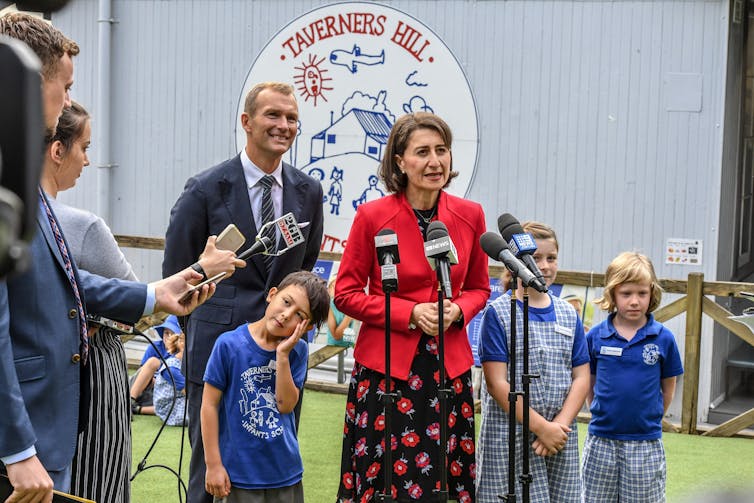 NSW premier Gladys Berijiklian announced in May 2018 they would review and overhaul the state curriculum.
Peter Rae/AAP
NSW premier Gladys Berijiklian announced in May 2018 they would review and overhaul the state curriculum.
Peter Rae/AAP
This shift is a response to growing evidence of the vital importance of capabilities to school performance, life outcomes and the economy. There is also evidence they can and should be developed in education settings from toddler-hood through to the tertiary years and beyond. Debate now turns to the best way to do so.
South Australia
NSW is not the only state marching forward with its own bold program. The new South Australian government is embarking on an ambitious school improvement agenda to “speed up” the learning growth of every student in every classroom. This system-wide reform combines tailored approaches with a heavier emphasis on planning, data, literacy and numeracy, building on their successful trial of the phonics check.
Read more: South Australia's trial of England's year one phonics check shows why we need it
Queensland
Queensland is steadily closing gaps in educational outcomes between Indigenous and non-Indigenous students.
It has also launched a new strategic plan. Notably, this includes early childhood education and post-school education, and additional measures for students in regional and rural areas, and students with disabilities. This is part of a cohesive approach to lifting and sustaining learning outcomes for all students.
Victoria
The re-election of the Andrews government in November sees the continuation of its Education State reform agenda. This includes funding more specialists in schools (teachers, doctors, speech pathologists, psychologists and social workers), building and renovating more schools, and providing more preschool.
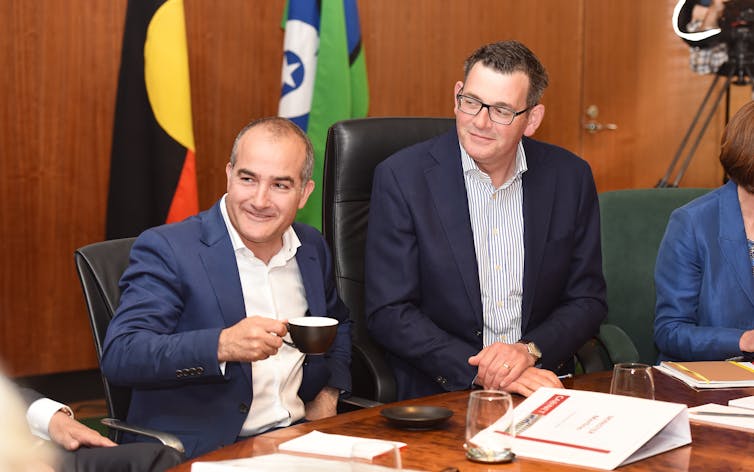 Victorian state education minister James Merlino (left) and Victoria’s Premier, Daniel Andrews (right).
Ellen Smith/AAP
Victorian state education minister James Merlino (left) and Victoria’s Premier, Daniel Andrews (right).
Ellen Smith/AAP
Yes, in a landmark policy announcement, Victoria’s youngest residents will receive two years of funded preschool. Given the benefits of quality preschool to all students, especially reducing developmental vulnerability on school entry, it’s a solid investment. It is one of the only strategies proven by research to lift outcomes for all children.
Read more: Research shows there are benefits from getting more three-year-olds into preschool
Western Australia
Western Australia is turning its attention to better recruitment, development and support for school leaders, as part of its broader system improvement strategy.
Tasmania
In Tasmania, the ongoing implementation of the 2017 Education Act kept schools and department officials busy – in large part due to giant shift to 13 years of compulsory schooling (prep to year 12) by 2020.
Until recently, many schools finished at year ten and students wanting to continue their education move to a new school, often in a new town. This is a major factor in Tassie’s low year 12 completion rate of only 72% - a full 10% lower than the national average.
The Northern Territory
And the NT launched it’s latest strategic plan with a focus on school leadership, quality, equity, differentiated learning, community engagement and better data.
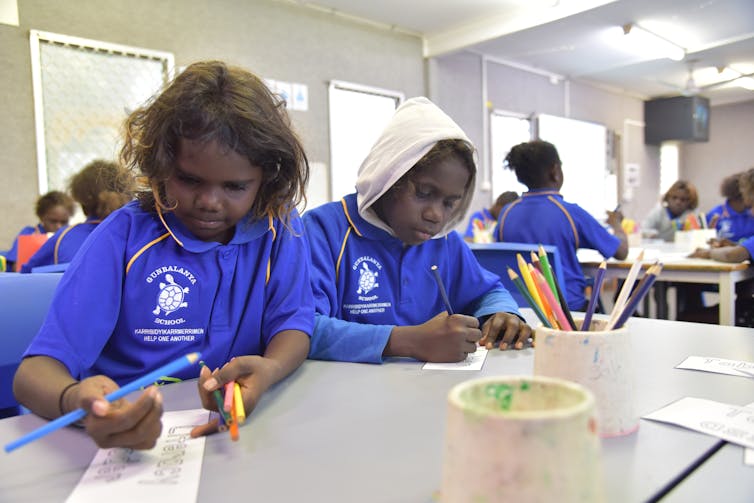 The NT is focusing on a strong public education system that ensures equity for all children.
Lucy Hughes Jones/AAP
The NT is focusing on a strong public education system that ensures equity for all children.
Lucy Hughes Jones/AAP
They also put out a new school funding model, with a greater emphasis on action and targeting to student needs and interventions.
ACT
The ACT became the first jurisdiction in Australia to provide every secondary student in a government school with a laptop. The ACT 2018-19 budget also provided A$9.2 million for research and trials of new teaching techniques in response to damning research that found once socio-economic backgrounds are taken into account, ACT students are up to a year behind their counterparts in other states and territories.
Turning to the federal level
Gonski 2.0
The March release of the Gonski 2.0 report was an early highlight. This review was tasked with identifying the school and classroom factors that can make the biggest, sustained difference to educational achievement. This includes what funding should be spent on, rather than structural issues like funding allocations.
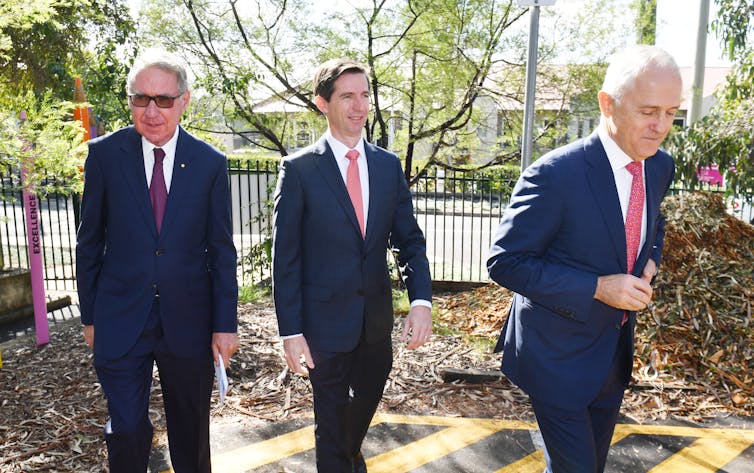 The Gonski 2.0 report, authored by David Gonski (far left) was released in March 2018.
Mick Tsikas
The Gonski 2.0 report, authored by David Gonski (far left) was released in March 2018.
Mick Tsikas
Gonski 2.0 advocated for a student-centred schooling system based on learning growth over time. Key recommendations focused on enhancing student voice, and better valuing of and support for teachers and school leaders, including providing them with the time and tools (including finer grain data, and data beyond NAPLAN) to focus on teaching and educational leadership, so they’re not swamped by administrative compliance.
Read more: Gonski review reveals another grand plan to overhaul education: but do we really need it?
(Astute readers will have noticed the key elements of Gonski 2.0 are already key elements of existing state and territory policy platforms and strategies.)
Happy anniversary?
2018 was the tenth anniversary of three major pillars of Australian schooling policy: NAPLAN, the Australian Curriculum, Assessment and Reporting Authority (ACARA) and the Melbourne Declaration of Educational Goals for Young Australians. Each celebrated this milestone amidst growing debate on whether they had served their intended purpose.
In the case of NAPLAN, this was accompanied by a growing call for its abolition or overhaul. NAPLAN was intended as a nationally-comparable, point-in-time dataset on a few vital areas to support schools and system leaders to make program and resourcing decisions. It was also meant to inform parental choice of schools.
But misunderstanding and misuse of NAPLAN has led to perverse effects. These include an overemphasis on preparation by some schools and families, resulting in anxiety and curriculum narrowing.
Read more: Five things we wouldn't know without NAPLAN
In with the new
2018 also saw the launch of a new national institution - the Gonski Institute focused on addressing education inequality across Australia. Despite - or perhaps because of - near continuous reforms at state and federal levels this past decade, inequality continues to grow.
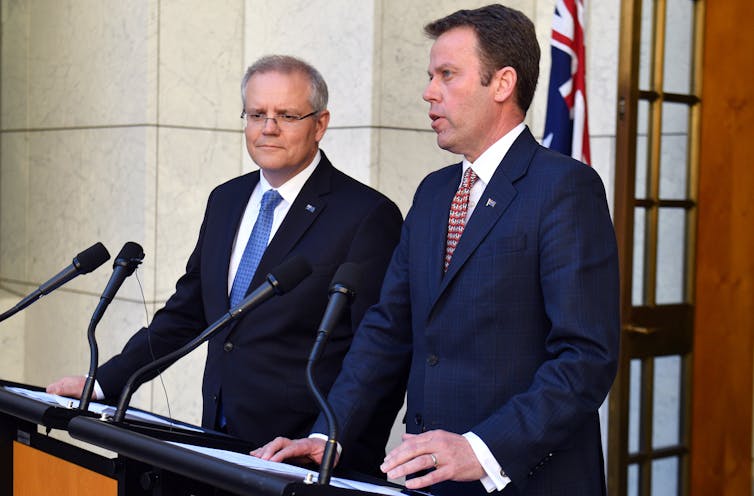 Dan Tehan, right, was appointed Federal Education Minister by Scott Morrison, left, in August 2018.
Mick Tsikas/AAP
Dan Tehan, right, was appointed Federal Education Minister by Scott Morrison, left, in August 2018.
Mick Tsikas/AAP
We also got a new federal education minister – Dan Tehan. He received the poisoned chalice of continuing the long and testy negotiations with the states on a five-year school funding agreement derived from the 2017 Education Act (the previous round of funding refoms) and the Gonski 2.0 findings.
These funding agreements are also a key element of the Coalition’s Quality Schools policy package, which has remained fairly constant the last few years.
It wasn’t until this week all jurisdictions were finally signed-up. But the last signatory - Victoria - only made a one-month deal. The Victorian government has expressed their concerns about a “dud deal” that provides more funding for students at non-government schools than those at government schools.
This short-term deal raises a bunch of questions as we head into the near year and the 2019 federal election - will there be by more short-term deals? Will other states seek to renegotiate better terms? Is Victoria banking on a change of government - and negotiating partner?
What do we know about federal Labor’s plans for education?
The key elements of Labor’s schooling policy pillars are restoring funding to schools cut by the Coalition. This includes, contentiously, restoring funding to some of the most over-funded non-government schools.
Read more: An education research institute won't take politics out of the classroom
They have also pledged an additional year of preschool for all kids across Australia, and have announced they will establish a national evidence institute for education policy.
 Federal Labor plans to establish a national evidence institute for education policy if they win the election in 2019.
Wayne Taylor/AAP
Federal Labor plans to establish a national evidence institute for education policy if they win the election in 2019.
Wayne Taylor/AAP
A new year and new goals
The updating of the national goals for Australian schooling by Australia’s state, territory and Commonwealth education ministers next year provides an opportunity to reflect on the purposes of schooling in the 21st century.
It’s hard to find fault with Minister Tehan’s statement that “Australia needs a shared agenda across the country to ensure alignment between policy, practice and delivery” and that young people need “a quality school education, tailored to individual needs”.
But it’s also true the 2008 goals were never achieved because it was never properly implemented.
Read more: Explaining Australia's school funding debate: what's at stake
Grand goals are well and good, but we need to also provision for implementation and work hard to make it happen. This means time, resources, clarity on each stakeholder’s role in creating an excellent and equitable schooling system (which enables all young Australians to become successful learners, confident and creative individuals), and active and informed citizens.
It’s time to commit to action and cooperation, regardless of who wins the 2019 elections.
Authors: Bronwyn Hinz, Director of Research and Development, Pivot Professional Learning; and Honorary Fellow, University of Melbourne





